A Self-Guided Angels & Demons Tour of Rome
 I’ve written before about the many Angels and Demons tours of Rome that are available in anticipation of the upcoming May 2009 release of the film. But I thought I’d also put together a self-guided Angels and Demons tour in case you’re not such a huge fan that you’ve got to follow the path in order, or with a guide. So here are the main stops on any good Angels & Demons tour.
I’ve written before about the many Angels and Demons tours of Rome that are available in anticipation of the upcoming May 2009 release of the film. But I thought I’d also put together a self-guided Angels and Demons tour in case you’re not such a huge fan that you’ve got to follow the path in order, or with a guide. So here are the main stops on any good Angels & Demons tour.
As a side note, this “self-guided Angels & Demons tour” assumes that you’ve read the book, and so therefore don’t need elements of the story pointed out to you. If you haven’t read the book, or did so long enough ago that you don’t recall specific points, you might want to sign up for one of the guided Angels & Demons tours (or re-read the book!). This self-guided tour just points out the various stops which serve as a backdrop for the story, and also talks about why each place is noteworthy – aside from the reasons Dan Brown might think it is.
>> I guess we’ll have to add to the list of movies filmed in Italy, won’t we?
Each stop on the tour is listed below the map, with information about the building or monument and visitor’s tips. And be sure to check out the “Angels & Demons” preview at the bottom of the post, complete with a Rome-themed slideshow underneath!
1. Pantheon
 The Pantheon may not look like the ruins in the Roman Forum, but this spectacular building is just as old. It was built in 125 A.D. and has been in constant use ever since – which is why it not only didn’t fall apart but also wasn’t used as a quarry.
The Pantheon may not look like the ruins in the Roman Forum, but this spectacular building is just as old. It was built in 125 A.D. and has been in constant use ever since – which is why it not only didn’t fall apart but also wasn’t used as a quarry.
While there’s not much in the way of artificial light inside the Pantheon, you’ll notice that the main source of light (and rain, when the weather’s bad) is the giant hole in the center of the dome. It’s called the “oculus,” and it originally served as a kind of chimney for the smoke from the ceremonial fires which were burned on the temple’s floor. It’s the oculus, however, that throws the “Angels & Demons” detectives for a loop at the start of the book, when they mistakenly assume it’s what is meant by the “demon hole” in the first riddle.
The Pantheon is located in central Rome roughly between the Piazza Navona and the Trevi Fountain. It’s open every day except Christmas Day, New Year’s Day, and May 1 – and it’s completely free.
2. Santa Maria del Popolo
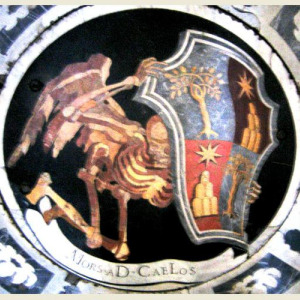 The unassuming facade of the Santa Maria del Popolo church in Rome belies the magnificence of this church’s interior. This church was built in the mid-15th century, although the site itself has been a place of worship since the early 11th century.
The unassuming facade of the Santa Maria del Popolo church in Rome belies the magnificence of this church’s interior. This church was built in the mid-15th century, although the site itself has been a place of worship since the early 11th century.
As is the case with many of the churches throughout Rome, the Santa Maria del Popolo contains artistic treasures which often get overlooked by tourists intent on hitting the big-name sights. Inside this church you’ll find two paintings by Caravaggio and frescoes by Pinturicchio. The gorgeous dome is lined with mosaics by Raphael. The facade itself was designed by Bernini. And it’s a Bernini sculpture inside that features in the “Angels & Demons” story – the “Habakkuk and the Angel” piece.
Santa Maria del Popolo is on the Piazza del Popolo north of the main historic sights of central Rome. It’s open daily (though Sunday open hours are more restricted due to services), and it’s free to visit.
3. St. Peter’s Square
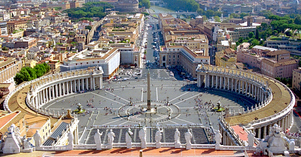 The enormous piazza in front of St. Peter’s Basilica is, appropriately, called St. Peter’s Square – but rather than feeling like a traditional piazza it feels more like a funnel. The columned arms that stretch out from the basilica and circle the piazza draw you in and pull you toward the church itself. Having been in this piazza during a Papal address, when there were thousands upon thousands of people in it, I can tell you that it still had plenty of room to move around. This is one public place that defies descriptions of its immense size.
The enormous piazza in front of St. Peter’s Basilica is, appropriately, called St. Peter’s Square – but rather than feeling like a traditional piazza it feels more like a funnel. The columned arms that stretch out from the basilica and circle the piazza draw you in and pull you toward the church itself. Having been in this piazza during a Papal address, when there were thousands upon thousands of people in it, I can tell you that it still had plenty of room to move around. This is one public place that defies descriptions of its immense size.
St. Peter’s Square was designed by Bernini in the mid-17th century, and the design was no small challenge given the existing buildings Bernini had to work around. At the piazza’s center is an Egyptian obelisk from the 13th century B.C.E. It’s at the base of the obelisk where you’ll find the “West Ponente” tile, one of the points referenced in the “Angels and Demons” book.
St. Peter’s Square is directly in front of St. Peter’s Basilica in Vatican City, which is entirely contained within Rome. Because it’s an outdoor space, St. Peter’s Square is always open and always free.
4. Santa Maria della Vittoria
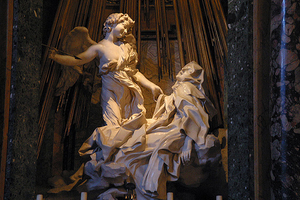 Santa Maria della Vittoria is another church in Rome that can get overlooked, despite what’s inside. It was built in the early 17th century, and it’s a very small church by Roman standards but contains one of the more famous sculptures in the “Angels & Demons” story.
Santa Maria della Vittoria is another church in Rome that can get overlooked, despite what’s inside. It was built in the early 17th century, and it’s a very small church by Roman standards but contains one of the more famous sculptures in the “Angels & Demons” story.
Bernini’s “Ecstasy of St. Teresa” graces the Cornaro Chapel in the Santa Maria della Vittoria church, just to the left of the altar. The statue represents the moment when, as St. Teresa says in her biography, she had a vision of an angel piercing her heart – but decades of onlookers have seen this masterpiece as much a work of erotica as religious transformation.
The Santa Maria della Vittoria church is tucked away on Via 20 Settembre, not far from the Termini train station, although in the novel the church is supposedly on nearby Piazza Barberini. It’s open daily, although it’s closed for a few hours each afternoon, and it’s free to enter.
5. Piazza Navona
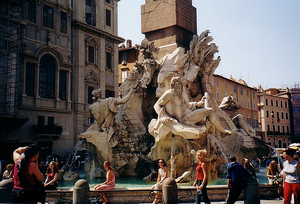 Walking through Rome, you’ll pass through countless piazzas – but when you first walk into Piazza Navona, you’ll immediately notice that it’s different. Instead of being a square or even angular, this piazza is a long oval. In fact, you might recognize that it looks like you could put a running track around the outside of it – which is an astute observation, as a Roman circus used to be in this very space.
Walking through Rome, you’ll pass through countless piazzas – but when you first walk into Piazza Navona, you’ll immediately notice that it’s different. Instead of being a square or even angular, this piazza is a long oval. In fact, you might recognize that it looks like you could put a running track around the outside of it – which is an astute observation, as a Roman circus used to be in this very space.
Back in the 1st century A.D., Romans would flock to the oblong arena on this site to watch various sports. The arena is long since gone, but its shape remains – and at its center is one of Rome’s many famous fountains. The Fountain of the Four Rivers is a Bernini sculptural work with an Egyptian obelisk in the middle. It’s this fountain which figures so prominently in the “Angels and Demons” story.
The Piazza Navona is in historic central Rome, due west from the Pantheon toward the Tiber River. As it’s a public square, it’s always open and always free – although the cafes which ring the piazza charge roughly the same as a mortgage for a coffee and a pastry.
6. Sant’Agnese in Agone
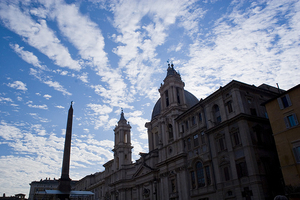 The Fountain of the Four Rivers in Piazza Navona stands right in front of the entrance of Sant’Agnese in Agone. The church was built in the mid-17th century and the facade was completed by Baroque master Borromini – who happened to be a bitter rival of Bernini, who designed the fountain at the church’s door. While a popular story says that Bernini designed the figures on the fountain to display a look of horror as they looked upon Borromini’s facade, the fountain was finished a full two years before construction on the church’s facade even began. So there.
The Fountain of the Four Rivers in Piazza Navona stands right in front of the entrance of Sant’Agnese in Agone. The church was built in the mid-17th century and the facade was completed by Baroque master Borromini – who happened to be a bitter rival of Bernini, who designed the fountain at the church’s door. While a popular story says that Bernini designed the figures on the fountain to display a look of horror as they looked upon Borromini’s facade, the fountain was finished a full two years before construction on the church’s facade even began. So there.
The Sant’Agnese in Agone church was built on the site where Saint Agnes was martyred – the arena which used to occupy the Piazza Navona space. And while you might think that Sant’Agnese in Agone referred to the agony she must have gone through in her death, it’s actually a reference to the ancient word for the games which used to be held at the arena. “Agone” were the games, and it’s also believed to have morphed into the word “Navona” that we use for the piazza today.
The Sant’Agnese in Agone church is on the Piazza Navona. It’s open every day except Monday, although it’s closed for a few hours each afternoon, and it’s free to enter.
7. Castel Sant’Angelo
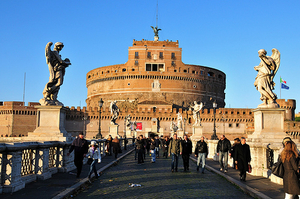 The imposing structure of Castel Sant’Angelo overlooking the Tiber River might look haunting even if you hadn’t read “Angels & Demons,” but it’ll undoubtedly be more so if you have. Originally built in the mid-2nd century as a mausoleum for the Roman emperor Hadrian and his wife, Castel Sant’Angelo has also served as a stronghold and a castle in its long history. At present, it’s a museum.
The imposing structure of Castel Sant’Angelo overlooking the Tiber River might look haunting even if you hadn’t read “Angels & Demons,” but it’ll undoubtedly be more so if you have. Originally built in the mid-2nd century as a mausoleum for the Roman emperor Hadrian and his wife, Castel Sant’Angelo has also served as a stronghold and a castle in its long history. At present, it’s a museum.
It’s probably not surprising that the Castel Sant’Angelo you see today doesn’t look exactly like it did when it was first constructed – simply being a military fortress wears on a building, apparently. Many of the former decorations were used as weapons to hurl onto invaders, and some of the treasures and tombs inside were looted by raiders. Still later, the Castel Sant’Angelo housed a castle, a chapel, a lavish Papal residence, and a prison.
In “Angels & Demons,” the building figures prominently – especially the secret elevated “Passetto di Borgo” which actually does lead from the Castel Sant’Angelo to Vatican City. Historically, it has served to spirit Popes to safety at times when the Vatican was under attack. Tours are strictly regulated, and visits must be booked months in advance. You can see an overhead view of the Passetto here.
The Castel Sant’Angelo is on Lungotevere Castello on the same side of the river as the Vatican. As mentioned, the building is now a museum, the Museo Nazionale di Castel Sant’Angelo. The museum is open Tuesday-Sunday from 9am-7pm, and closed Mondays, Christmas Day and New Year’s Day. A regular entry ticket is €5, with reduced prices for EU citizens between 18-25, and over 65.
8. St. Peter’s Basilica
 I’ve lovingly referred to St. Peter’s Basilica as “the Catholic mothership” in the past, but even if that’s meant to be tongue-in-cheek it’s kind of an accurate statement anyway. This massive basilica is, after all, the largest church in Christendom, one of the holiest sites in Christianity, and the place where the Pope performs mass on a pretty regular basis. I’d say that gives it “mothership” qualifications.
I’ve lovingly referred to St. Peter’s Basilica as “the Catholic mothership” in the past, but even if that’s meant to be tongue-in-cheek it’s kind of an accurate statement anyway. This massive basilica is, after all, the largest church in Christendom, one of the holiest sites in Christianity, and the place where the Pope performs mass on a pretty regular basis. I’d say that gives it “mothership” qualifications.
The tomb of St. Peter himself, the first Pope, is said to be below the main altar at St. Peter’s Basilica, and many subsequent Popes are also buried beneath the church. Although it is St. Peter’s tomb that figures so prominently in “Angels and Demons,” that’s one place you’ll need quite a bit of advance planning to visit – secret Scavi tours of the excavated tombs under St. Peter’s Basilica exist, but only 150 people are admitted each day.
Visiting St. Peter’s Basilica is significantly easier. The church sits at the center of Vatican City on the opposite side of the Tiber River from historic central Rome, and although it’s free to enter you’ll need to stand in line and go through a metal detector – and be sure you’re wearing appropriate clothing, or you’ll be turned away. It’s open daily from about 7am until 6pm.
9. Sistine Chapel
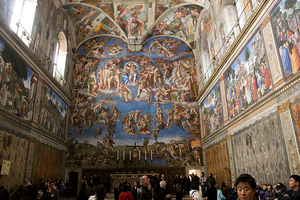 Arguably the most popular point in any tour of the Vatican Museums, the Sistine Chapel serves other purposes than just being pretty for visitors to look at. It’s only one of the chapels in the official Papal residence, but it’s been used as the space for the selection of a new Pope since 1492.
Arguably the most popular point in any tour of the Vatican Museums, the Sistine Chapel serves other purposes than just being pretty for visitors to look at. It’s only one of the chapels in the official Papal residence, but it’s been used as the space for the selection of a new Pope since 1492.
The most famous things about the Sistine Chapel are easily the collection of frescoes by Michelangelo – from his many-paneled ceiling to the massive Last Judgment behind the altar. The ceiling alone took him four years, and the altar piece was started when he was 60 years old. While the election of a new Pope – called a Papal conclave – is strictly off-limits to anyone who’s not a voting Cardinal, in “Angels & Demons” two of the main characters storm the party to try to avert disaster.
The Sistine Chapel is sort of wedged between the Vatican Museums and St. Peter’s Basilica, and the only way to visit is by buying a ticket to the Vatican Museum. It’s at the very end of the tour, and you’ll sometimes see people rushing through the gargantuan museum just to get to the chapel itself, but give yourself enough time to see and enjoy the rest of it before alighting in the famous chapel. Adult admission is €13 at the moment. The Vatican Museum open hours aren’t nearly as straightforward as one would hope. The museums are often closed for what seems like no apparent reason, although the reason is usually a lesser-known Catholic holiday. If you’re concerned about the days the museums will be open during your stay in Rome, be sure to check the official calendar for the current year’s open and closed days.
>> Fellow Italophile Angela Nickerson wrote an ebook called “Rome’s Angels & Demons: The Insider’s Guide” which you can download here for free.
original photos, top to bottom, by: Blue Serge, r_neches, antmoose, David Paul Ohmer, KeepOnClicking, Aschaf, soyignatius, Ed Yourdon, jimmyharris, Andreas Solberg